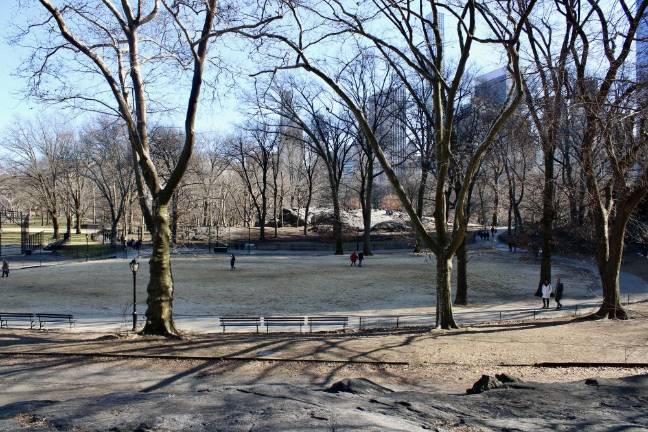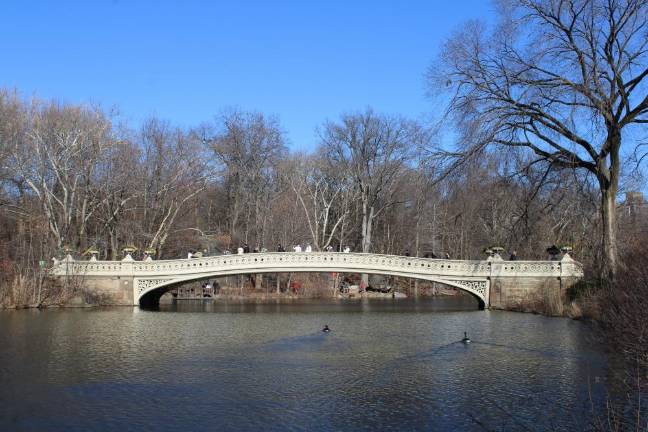Climate Change Research Begins in Central Park
The Central Park Conservatory opens The Central Park Climate Lab in collaboration with the Yale School of the Environment


Central Park is a green oasis in a concrete city. Its crisscrossing pathways offer a refuge from the hubbub of traffic for runners, dog walkers, and frisbee players who take advantage of the park’s open spaces. Not only does the park offer a recreational paradise, but the sloping lawns and brick bridges expose visitors to the tranquility of the natural environment. For fifty percent of all New Yorkers, access to nature comes solely from trips to city parks, according to the Central Park Conservancy.
Urban parks are as susceptible to the effects of climate change as coastlines and icebergs. This was made clear last September when Hurricane Ida swept through New York, flooding the subway, and turning streets into swimming lanes. In an hour the storm poured a record 3.15 inches of rain on Central Park, damaging around fifty trees, and flooding the Boathouse. This followed a summer where at least six official heat waves baked the paved walkways and algal blooms appeared in Central Park’s water bodies, both climate change- related phenomena.
With these recent weather events in mind, Norman Selby from the Central Park Conservancy Board of Trustees was having conversations with friends and colleagues passionate about climate action. “As far as they’re concerned, it’s the fundamental challenge facing our generation and anything else is moving deck chairs on the Titanic,” said Selby.
From getting climate legislation passed in Congress to mandating carbon taxes, Selby was hearing big picture action and long-term work. While this work is undeniably important, he couldn’t stop thinking about how these changes wouldn’t come into effect for the next five or so years. In the meantime, more crises would continue to impact communities at the local level.
“There has got to be things we can do locally to figure out the impact of climate change, to study it at work,” said Selby. From his years of experience with the Central Park Conservancy, Selby knew Central Park would be an ideal location for climate research because of the high level of management that goes into maintaining the park. “We have a database with every single tree on it,” said Selby. “We know how much garbage we took out of Central Park yesterday. It’s a very analytically, professionally run organization.”
Yale Scientists
He approached the Central Park Conservancy about exploring climate change research. With their support, Selby reached out to the Yale School of the Environment, which has a rich history of environmental research and employs some of the best scientists in the field. He got in contact with Mark Bradford, Professor of Soils and Ecosystem Ecology, who was enthusiastic about the opportunity. The collaboration, along with the Natural Areas Conservancy, was in the works for some time before being officially announced in January 2022.
Urban parks are vital pieces of climate resilient city infrastructure because they cool us down. Known as the urban island heat effect, cities generally experience warmer temperatures than rural areas because buildings and concrete sidewalks absorb heat rather than deflecting it. There is also less tree cover in cities to provide shady respites from the sun’s heat.
“With about 55% of the world’s population now living in urban areas, urbanization plays an increasingly important role in how we manage and mitigate the impact of global climate change,” said Professor Karen Seto, Frederick C. Hixon Professor of Geography and Urbanization Science at the Yale School of the Environment in a statement.
There is currently a lack of information around how urban parks spaces should be managed as our summers get hotter and weather events intensify. The World Economic Forum recently pointed out a widespread underinvestment in nature-based solutions within cities. Researchers with the Central Park Climate Lab will record the impact of climate change on site using digital mapping technology. They will also work with policymakers to develop strategies on how urban parks can make cities more climate resilient.
Fundraising Expertise
The Central Park Climate Lab is currently busy hiring employees, fundraising, and building out their scientific approach for an April start date. They will be announcing a project director soon who will work closely with Salmaan Khan, Director of Research and Special Projects for the Central Park Conservancy.
Selby said the intention behind the early announcement of the project was to get the message out there. The project will require securing four to five million dollars to fund its operations for three years. With the fundraising expertise of the Central Park Conservancy and the Yale School of the Environment, Shelby isn’t worried about acquiring the necessary capital.
While the project is still new, the lab hopes to expand their research to other parks and inspire urban climate change research and policy action on a larger scale. Mayor Eric Adams supported the project in a recent press release, emphasizing how essential parks are for New Yorkers. “The Central Park Climate Lab begins a new era in research and cooperation that will give our park professionals improved tools to combat the climate crisis, and it will be a model for urban parks across the country,” Adams said.
Located at the center of one the nation’s most densely populated cities, even Central Park, which stands as a timeless bastion of leafy calm, is starting to feel the impact of our warming world.